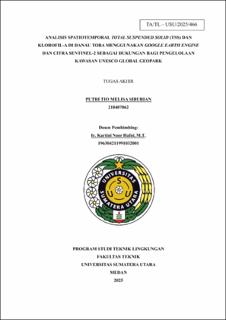Analisis Spatiotemporal Total Suspended Solid (TSS) dan Klorofil-A di Danau Toba Menggunakan Google Earth Engine dan Citra Sentinel-2 sebagai Dukungan bagi Pengelolaan Kawasan UNESCO Global Geopark
Spatial-Temporal Analysis of Total Suspended Solids (TSS) and Chlorophyll-A in Lake Toba Using Google Earth Engine and Sentinel-2 Imagery to Support Management of the UNESCO Global Geopark Area

Date
2025Author
Siburian, Putri Tio Melisa
Advisor(s)
Hafni, Kartini Noor
Metadata
Show full item recordAbstract
Lake Toba, the world's largest volcanic lake, has been recognized as a UNESCO Global Geopark since 2020 and a Super Priority Tourism Destination (DPSP). The decline in water quality, marked by an increase in nutrients and suspended solids, has the potential to trigger eutrophication and reduce tourist appeal.
The main objective of this study is to analyze the spatial and temporal distribution of Total Suspended Solids (TSS) and Chlorophyll-a in Lake Toba during the period 2022-2024 using Sentinel-2 satellite imagery and the Google Earth Engine (GEE) platform. This study also evaluates the relationship between water quality parameters and potential pollution sources in the lake area. The methodology includes a quantitative descriptive approach with TSS modeling using various band ratio-based regression algorithms (such as Budhiman, Laili, Mubarok, linear, logarithmic, and exponential), as well as Chlorophyll-a modeling through relevant Sentinel-2 band ratios. Validation was conducted by comparing satellite estimation results with in-situ data from the Online Water Quality Monitoring System (ONLIMO).
TSS analysis results consistently show significant spatial heterogeneity; deep waters tend to be clear, while coastal and shallow areas repeatedly show increased turbidity, particularly in the Northwest (Paropo, Haranggaol, Silalahi), Uluan Peninsula (Loembuan, Nainggolan), and South and Southeast (Muara, Balige, Porsea) regions. Temporal patterns indicate that Lake Toba tends to be clear in April and reaches peak turbidity in August-September, reflecting strong seasonal influences. Initial results also show significant spatial variation in TSS and Chlorophyll-a concentrations, with higher values near densely populated areas and fish farming activities.
Overall, this study provides a comprehensive scientific understanding of Lake Toba's water quality dynamics through the integration of satellite and in-situ data. These findings are crucial as a scientific basis for the management and conservation of Lake Toba, helping to identify priority areas for mitigation interventions, monitor anthropogenic impacts, and support data-driven decision-making for geopark sustainability.
Collections
- Undergraduate Theses [404]
